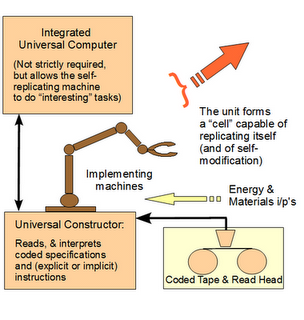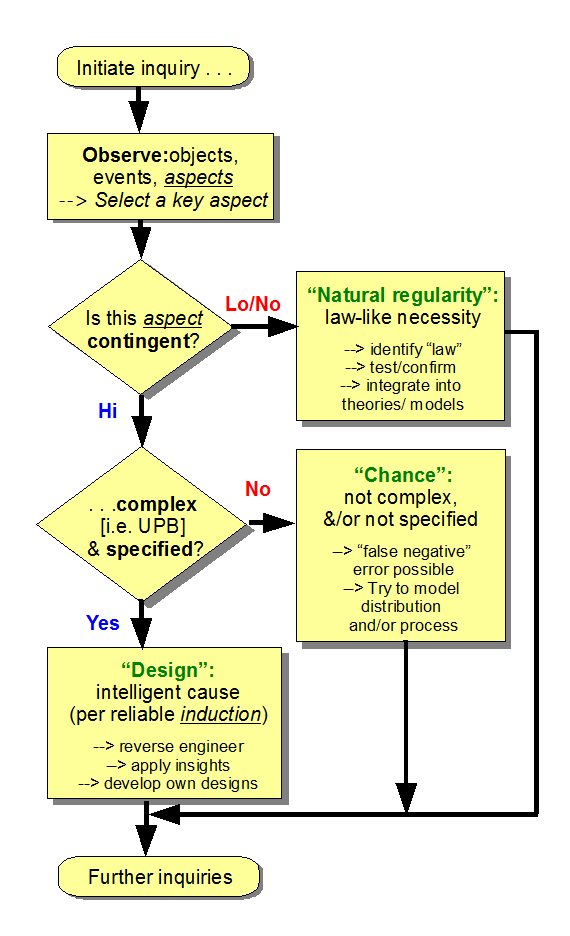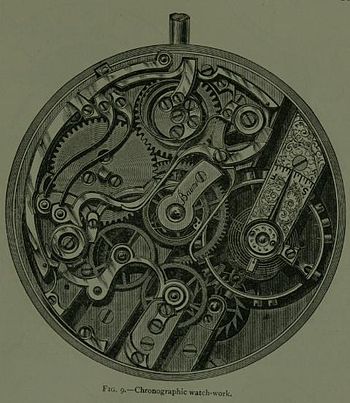Sometimes, one of the most telling issues in a debate is the point the other side utterly refuses to take up.
The one it tries to pretend is just not there.
Even, as it hastens off to a red herring dragged away to strawman caricatures laced with loaded accusations or insinuations and set alight to cloud, poison, confuse and utterly polarise the atmosphere; frustrating the process of seeking truth through reasoned civil discussion.
That is why I think it is a strong indication that we are on to something serious when my clipping and citing Paley’s watch example in full form — not the common strawman tactic caricature — led to an insistent attempt to deflect discussion into accusations of censorship.
(BTW, just for info, sock puppetry is typically a part of abusive and enabling conduct on the Internet. There is and can be no right to demand acceptance or tolerance of abusive and enabling behaviour as a price for attempted discussion. There is no right to be a cyber-bully, or to slander or to play outing games, or to try to out and intimidate uninvolved family, or to stalk online or on the ground. And, he who would unjustly threaten a man’s livelihood or reputation that is the basis for livelihood, would threaten his life. And, forums that host or enable such abusive behaviour are obviously not proper venues for reasonable discussion. In the meanwhile, I here continue to put up things FTR that need to be said without having to deal with dreary repetition of destructive derailing tactics. In short, I find myself forced to resort for now to the older exchange of articles approach for a little while, to get a basic point through. [If you want to understand some of why I am doing this cf. here. For deeper background, cf. here in context. And of course, the parable here by Plato still has much to teach us about media manipulation and the cultural establishment of powerful but false ideologies. So does Luke’s account of Paul’s voyage to Rome, on how democracies and governance can go off the rails into a march of folly.])
Oh, yes, series so far:
Of course, the best answer to toxic distractions is to refocus the key point, so, let me now clip:
_______________
>>>As a sparker for thought, let me clip Paley’s classic discussion in Nat Theol, on finding a watch in a field:
IN crossing a heath, suppose I pitched my foot against a stone, and were asked how the stone came to be there; I might possibly answer, that, for any thing I knew to the contrary, it had lain there for ever: nor would it perhaps be very easy to show the absurdity of this answer. But suppose I had found a watch upon the ground, and it should be inquired how the watch happened to be in that place; I should hardly think of the answer which I had before given, that, for any thing I knew, the watch might have always been there. Yet why should not this answer serve for the watch as well as for the stone? why is it not as admissible in the second case, as in the first? For this reason, and for no other, viz. that, when we come to inspect the watch, we perceive (what we could not discover in the stone) that its several parts are framed and put together for a purpose, e. g. that they are so formed and adjusted as to produce motion, and that motion so regulated as to point out the hour of the day; that, if the different parts had been differently shaped from what they are, of a different size from what they are, or placed after any other manner, or in any other order, than that in which they are placed, either no motion at all would have been carried on in the machine, or none which would have answered the use that is now served by it. To reckon up a few of the plainest of these parts, and of their offices, all tending to one result:– We see a cylindrical box containing a coiled elastic spring, which, by its endeavour to relax itself, turns round the box. We next observe a flexible chain (artificially wrought for the sake of flexure), communicating the action of the spring from the box to the fusee. We then find a series of wheels, the teeth of which catch in, and apply to, each other, conducting the motion from the fusee to the balance, and from the balance to the pointer; and at the same time, by the size and shape of those wheels, so regulating that motion, as to terminate in causing an index, by an equable and measured progression, to pass over a given space in a given time. We take notice that the wheels are made of brass in order to keep them from rust; the springs of steel, no other metal being so elastic; that over the face of the watch there is placed a glass, a material employed in no other part of the work, but in the room of which, if there had been any other than a transparent substance, the hour could not be seen without opening the case. This mechanism being observed (it requires indeed an examination of the instrument, and perhaps some previous knowledge of the subject, to perceive and understand it; but being once, as we have said, observed and understood), the inference, we think, is inevitable, that the watch must have had a maker: that there must have existed, at some time, and at some place or other, an artificer or artificers who formed it for the purpose which we find it actually to answer; who comprehended its construction, and designed its use.
I. Nor would it, I apprehend, weaken the conclusion, that we had never seen a watch made; that we had never known an artist capable of making one; that we were altogether incapable of executing such a piece of workmanship ourselves, or of understanding in what manner it was performed; all this being no more than what is true of some exquisite remains of ancient art, of some lost arts, and, to the generality of mankind, of the more curious productions of modern manufacture. Does one man in a million know how oval frames are turned? . . .
. . . then (as a thought exercise) finding the additional property of self-replication in said watch, per ch 2:
 >>SUPPOSE, in the next place, that the person who found the watch, should, after some time, discover that, in addition to all the properties which he had hitherto observed in it, it possessed the unexpected property of producing, in the course of its movement, another watch like itself (the thing is conceivable); that it contained within it a mechanism, a system of parts, a mould for instance, or a complex adjustment of lathes, files, and other tools, evidently and separately calculated for this purpose; let us inquire, what effect ought such a discovery to have upon his former conclusion.
>>SUPPOSE, in the next place, that the person who found the watch, should, after some time, discover that, in addition to all the properties which he had hitherto observed in it, it possessed the unexpected property of producing, in the course of its movement, another watch like itself (the thing is conceivable); that it contained within it a mechanism, a system of parts, a mould for instance, or a complex adjustment of lathes, files, and other tools, evidently and separately calculated for this purpose; let us inquire, what effect ought such a discovery to have upon his former conclusion.
I. The first effect would be to increase his admiration of the contrivance, and his conviction of the consummate skill of the contriver. Whether he regarded the object of the contrivance, the distinct apparatus, the intricate, yet in many parts intelligible mechanism, by which it was carried on, he would perceive, in this new observation, nothing but an additional reason for doing what he had already done,–for referring the construction of the watch to design, and to supreme art. If that construction without this property, or which is the same thing, before this property had been noticed, proved intention and art to have been employed about it; still more strong would the proof appear, when he came to the knowledge of this further property, the crown and perfection of all the rest.
II. He would reflect, that though the watch before him were, in some sense, the maker of the watch, which was fabricated in the course of its movements, yet it was in a very different sense from that, in which a carpenter, for instance, is the maker of a chair; the author of its contrivance, the cause of the relation of its parts to their use. With respect to these, the first watch was no cause at all to the second: in no such sense as this was it the author of the constitution and order, either of the parts which the new watch contained, or of the parts by the aid and instrumentality of which it was produced. We might possibly say, but with great latitude of expression, that a stream of water ground corn: but no latitude of expression would allow us to say, no stretch of conjecture could lead us to think, that the stream of water built the mill, though it were too ancient for us to know who the builder was. What the stream of water does in the affair, is neither more nor less than this; by the application of an unintelligent impulse to a mechanism previously arranged, arranged independently of it, and arranged by intelligence, an effect is produced, viz. the corn is ground. But the effect results from the arrangement. The force of the stream cannot be said to be the cause or author of the effect, still less of the arrangement. Understanding and plan in the formation of the mill were not the less necessary, for any share which the water has in grinding the corn: yet is this share the same, as that which the watch would have contributed to the production of the new watch, upon the supposition assumed in the last section. Therefore,
III. Though it be now no longer probable, that the individual watch, which our observer had found, was made immediately by the hand of an artificer, yet doth not this alteration in anywise affect the inference, that an artificer had been originally employed and concerned in the production. The argument from design remains as it was. Marks of design and contrivance are no more accounted for now, than they were before . . . >>
Paley goes on:
>>Nor is any thing gained by running the difficulty farther back, i. e. by supposing the watch before us to have been produced from another watch, that from a former, and so on indefinitely. Our going back ever so far, brings us no nearer to the least degree of satisfaction upon the subject. Contrivance is still unaccounted for. We still want a contriver. A designing mind is neither supplied by this supposition, nor dispensed with. If the difficulty were diminished the further we went back, by going back indefinitely we might exhaust it. And this is the only case to which this sort of reasoning applies. Where there is a tendency, or, as we increase the number of terms, a continual approach towards a limit, there, by supposing the number of terms to be what is called infinite, we may conceive the limit to be attained: but where there is no such tendency, or approach, nothing is effected by lengthening the series. There is no difference as to the point in question (whatever there may be as to many points), between one series and another; between a series which is finite, and a series which is infinite. A chain, composed of an infinite number of links, can no more support itself, than a chain composed of a finite number of links . . . The machine which we are inspecting, demonstrates, by its construction, contrivance and design. Contrivance must have had a contriver; design, a designer; whether the machine immediately proceeded from another machine or not. That circumstance alters not the case. That other machine may, in like manner, have proceeded from a former machine: nor does that alter the case; contrivance must have had a contriver . . . >>
Paley is direct: “[c]ontrivance must have had a contriver; design, a designer . . .”
That is, we may extend the per aspect causal explanatory framework:
 . . . to include the further argument that
. . . to include the further argument that
P1: design processes call out for explanation, and
P2: the only reasonable explanation of such is that the functionally specific, complex organisation and associated information [FSCO/I] we see point to intelligently directed configuration as proximate, actuating cause and onwards to the intelligence and purpose of a contriver as the first, root cause. So,
___________________________________________
C: such calls for the explanation: “[c]ontrivance must have had a contriver; design, a designer . . .”>>>
_______________
Let us hear the answer to this, after 150 years of putting up the but life forms replicate so the machine analogy is flawed dismissive talking point. For, for several decades now, we have learned that the way that cellular replication works, the foundation of reproduction, is based on sophisticated nanotechnology involving codes, algorithms, communication networks, controlled molecular executing nanotechnology and more to implement a von Neumann kinematic self replicator [vNSR].
So, we have come full circle to the direct relevance of Paley’s argument: “[c]ontrivance must have had a contriver; design, a designer . . .” END
F/N: Commenter Box remarks:
>>The parts of a watch form a functional unity—they are all aimed at performing one single function. This harmonious directionality of the parts cannot be explained by the parts themselves, since the parts have no intrinsic tendency to perform the function. In order to explain the harmonious directionality of the parts an external cause is required.
1. A watch has one single function
2. All the parts are aimed at performing this function
3. This harmonious directionality cannot be explained by the parts
Conclusion: an external cause is responsible for the harmonious directionality of the parts.
The following qualities are necessarily part of the cause in order to be sufficient: plan, overview, knowledge of parts and skillful manipulation. IOW a “designer”.>>
